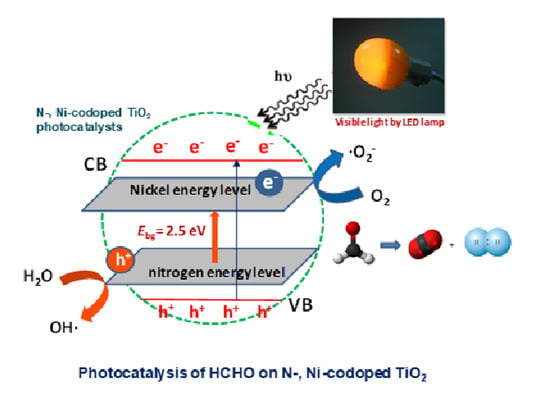Visible Light Photocatalytic Activity of Thin Film Coated on Polycarbonate Surface with N- and Ni-Codoped TiO2 Photocatalyst
Abstract
1. Introduction
2. Results and Discussion
2.1. Physicochemical Properties of NNT
2.2. Visible Light Photocatalytic Activity of NNT Photocatalysts
2.3. Antibacterial Properties of NNT in Visible Light
3. Materials and Methods
3.1. Preparation of NNT Photocatalysts
3.2. Photocatalytic Decomposition of Formaldehyde in Visible Light
3.3. Estimation of Antibacterial Properties
3.4. Analysis
4. Conclusions
Author Contributions
Funding
Acknowledgments
Conflicts of Interest
References
- Fujishima, A.; Honda, K. Electrochemical photolysis of water at a semicounductor electorode. Nature 1972, 238, 37–38. [Google Scholar] [CrossRef] [PubMed]
- Yang, X.Y.; Wolcott, A.; Wang, G.M.; Sobo, A.; Fitzmorris, R.C.; Qian, F.; Zhang, J.Z.; Li, Y. Nitrogen-doped ZnO nanowire arrays for photoelectro chemical water splitting. Nano Lett. 2009, 9, 2331–2336. [Google Scholar] [CrossRef] [PubMed]
- Wolcott, A.; Smith, W.A.; Kuykendall, T.R.; Zhao, Y.; Zhang, J.Z. Photoelectrochemical Study of Nanostructured ZnO Thin Films for Hydrogen Generation from Water Splitting. Adv. Funct. Mater. 2009, 19, 1849–1856. [Google Scholar] [CrossRef]
- Schneider, J.; Matsuoka, M.; Takeuchi, M.; Zhang, J.; Horiuchi, Y.; Anpo, M.; Bahnemann, D.W. Understanding TiO2 Photocatalysis: Mechanisms and Materials. Chem. Rev. 2014, 114, 9919–9986. [Google Scholar] [CrossRef]
- Ma, Y.; Wang, X.; Jia, Y.; Chen, X.; Han, H.; Li, C. Titanium Dioxide-Based Nanomaterials for Photocatalytic Fuel Generations. Chem. Rev. 2014, 114, 9987–10043. [Google Scholar] [CrossRef]
- Wu, H.; Zhang, Z. High photoelectrochemical water splitting performance on nitrogen doped double-wall TiO2 nanotube array electrodes. Int. J. Hydrogen Energy 2011, 36, 13481–13487. [Google Scholar] [CrossRef]
- Puga, A.V. Photocatalytic production of hydrogen from biomass-derived feedstocks. Coord. Chem. Rev. 2016, 315, 1–66. [Google Scholar] [CrossRef]
- Dhakshinamoorthy, A.; Navalon, S.; Corma, A.; Garcia, H. Photocatalytic CO2 reduction by TiO2 and related titanium containing solids. Energy Environ. Sci. 2012, 5, 9217–9233. [Google Scholar] [CrossRef]
- Tian, J.; Leng, Y.; Zhao, Z.; Xia, Y.; Sang, Y.; Hao, P. Carbon quantum dots/hydrogenated TiO2 nanobelt hetero structures and their broad spectrum photocatalytic properties under UV, visible, and near-infrared irradiation. Nano Energy 2015, 11, 419–427. [Google Scholar] [CrossRef]
- Sharotri, N.; Sud, D. A greener approach to synthesize visible light responsive nanoporous S-doped TiO 2 with enhanced photocatalytic activity. N. J. Chem. 2015, 39, 2217–2223. [Google Scholar] [CrossRef]
- Sharotri, N.; Sud, D. Ultrasound-assisted synthesis and characterization of visible light responsive nitrogen-doped TiO 2 nanomaterials for removal of 2-Chlorophenol. Desalin. Water Treat. 2015, 57, 1–13. [Google Scholar] [CrossRef]
- Yao, Z.; Jia, F.; Tian, S.; Li, C.; Jiang, Z.; Bai, X. Microporous Ni-Doped TiO2 film Photocatalyst by Plasma Electrolytic Oxidation. ACS Appl. Mater. Interfaces 2010, 2, 2617–2622. [Google Scholar] [CrossRef] [PubMed]
- Yu, X.; Kim, B.; Kim, Y.K. Highly Enhanced Photoactivity of Anatase TiO2 Nanocrystals by Controlled Hydrogenation-Induced Surface Defects. ACS Catal. 2013, 3, 2479–2486. [Google Scholar] [CrossRef]
- Guo, Z.; Zhang, B.; Li, H.; Ming, H.; Bala, H.; Yao, S.; Zhang, J.; Fu, W.; Cao, J.; Sun, G.; et al. Visible light responsive CsPbBr3/TiO2 photocatalyst with long-term stability in aqueous solution. Mater. Lett. 2020, 274, 128041. [Google Scholar] [CrossRef]
- Shenoy, S.; Sridharan, K. Bismuth oxybromide nanoplates embedded on activated charcoal as effective visible light driven photocatalyst. Chem. Phys. Lett. 2020, 749, 137435. [Google Scholar] [CrossRef]
- Khan, H.; Usen, N.; Boffito, D.C. Spray-dried microporous Pt/TiO2 degrades 4-chlorophenol under UV and visible light. J. Environ. Chem. Eng. 2019, 7, 103267. [Google Scholar] [CrossRef]
- Qiu, H.; Ma, X.; Sun, C.; Zhao, B.; Chen, F. Surface oxygen vacancies enriched Pt/TiO2 synthesized with a defect migration strategy for superior photocatalytic activity. Appl. Surf. Sci. 2020, 506, 145021. [Google Scholar] [CrossRef]
- Asahi, R.; Morikawa, T.; Ohwaki, T.; Aoki, K.; Taga, Y. Visible-Light Photocatalysis in Nitrogen-Doped Titanium Oxides. Science 2001, 293, 269–271. [Google Scholar] [CrossRef]
- Yamashita, H.; Harada, M.; Misaka, J.; Takeuchi, M.; Ikeue, K.; Anpo, M. Degradation of propanol diluted in water under visible light irradiation using metal ion-implanted titanium dioxide photocatalysts. J. Photochem. Photobiol. A Chem. 2002, 148, 257–261. [Google Scholar] [CrossRef]
- Dvoranová, D.; Brezová, V.; Mazúr, M.; Malati, M.A. Investigations of metal-doped titanium dioxide photocatalysts. Appl. Catal. B Environ. 2002, 37, 91–105. [Google Scholar] [CrossRef]
- Kemp, T.J.; McIntyre, R.A. Transition metal-doped titanium (IV) dioxide: Characterization and influence on photodegradation of poly (vinyl chloride). Polym. Degrad. Stab. 2006, 91, 165–194. [Google Scholar] [CrossRef]
- Kapoor, P.; Uma, S.; Rodriguez, S.; Klabunde, K. Aerogel processing of MTi2O5 (M = Mg, Mn, Fe, Co, Zn, Sn) compositions using single source precursors: Synthesis, characterization and photocatalytic behavior. J. Mol. Catal. A Chem. 2005, 229, 145–150. [Google Scholar] [CrossRef]
- Rauf, M.; Meetani, M.A.; Hisaindee, S. An overview on the photocatalytic degradation of azo dyes in the presence of TiO2 doped with selective transition metals. Desalination 2011, 276, 13–27. [Google Scholar] [CrossRef]
- Kara, F.; Kurban, M.; Coşkun, B. Evaluation of electronic transport and optical response of two-dimensional Fe-doped TiO2 thin films for photodetector applications. Optik 2020, 210, 164605. [Google Scholar] [CrossRef]
- Herrmann, J.-M. Detrimental cationic doping of titania in photocatalysis: Why chromium Cr3+-doping is a catastrophe for photocatalysis, both under UV- and visible irradiations. New J. Chem. 2012, 36, 883–890. [Google Scholar] [CrossRef]
- Jedsukontorn, T.; Ueno, T.; Saito, N.; Hunsom, M. Narrowing bandgap energy of defective black TiO2 fabricated by solution plasma process and its photocatalytic activity on glycerol transformation. J. Alloys Compd. 2018, 757, 188–199. [Google Scholar] [CrossRef]
- Kumar, A.; Raizada, P.; Singh, P.; Saini, R.V.; Saini, A.K.; Hosseini-Bandegharaei, A. Perspective and status of polymeric graphitic carbon nitride based Z-scheme photocatalytic systems for sustainable photocatalytic water purification. Chem. Eng. J. 2020, 391, 123496. [Google Scholar] [CrossRef]
- Huang, C.-W.; Nguyen, V.-H.; Zhou, S.-R.; Hsu, S.-Y.; Tan, J.-X.; Wu, K.C.-W. Metal–organic frameworks: Preparation and applications in highly efficient heterogeneous photocatalysis. Sustain. Energy Fuels 2020, 4, 504–521. [Google Scholar] [CrossRef]
- Raizada, P.; Sudhaik, A.; Singh, P.; Hosseini-Bandegharaei, A.; Thakur, P. Converting type II AgBr/VO into ternary Z scheme photocatalyst via coupling with phosphorus doped g-C3N4 for enhanced photocatalytic activity. Sep. Purif. Technol. 2019, 227, 115692. [Google Scholar] [CrossRef]
- Hozumi, A.; Takai, O. Effect of hydrolysis groups in fluoro-alkyl silanes on water repellency of transparent two-layer hard-coatings. Appl. Surf. Sci. 1996, 103, 431–441. [Google Scholar] [CrossRef]
- Moustaghfir, A.; Tomasella, E.; Rivaton, A.; Mailhot, B.; Jacquet, M.; Gardette, J.L.; Cellier, J. Sputtered zinc oxide coatings: Structural study and application to photoprotection of the polycarbonate. Surf. Coat. Technol. 2004, 180–181, 642–645. [Google Scholar] [CrossRef]
- Hetemi, D.; Pinson, J. Surface functionalisation of polymers. Chem. Soc. Rev. 2017, 46, 5701–5713. [Google Scholar] [CrossRef] [PubMed]
- Chen, G.; Wang, Z.K.; Zheng, H.; Thwe, A.; Lam, Y. Investigation on polycarbonate surface wetting property with femtosecond laser irradiation and ultrasonic treatment. Opt. Laser Technol. 2019, 115, 316–324. [Google Scholar] [CrossRef]
- Puga, A.V.; Garcia-Valls, R.; Fernández-Prieto, S.; Smets, J.; York, D. Dual xanthan gum/poly (vinyl acetate) or alkyl-functionalized poly (vinyl alcohol) films as models for advanced coatings. J. Appl. Polym. Sci. 2014, 131, 40870. [Google Scholar] [CrossRef]
- Kang, E.-T.; Tan, K.L.; Kato, K.; Uyama, Y.; Ikada, Y. Surface Modification and Functionalization of Polytetrafluoroethylene Films. Macromolecules 1996, 29, 6872–6879. [Google Scholar] [CrossRef]
- Hwang, D.; Moon, J.; Shul, Y.; Jung, K.; Kim, D.; Lee, D. Scratch Resistant and Transparent UV-Protective Coating on Polycarbonate. J. Solgel Sci. Technol. 2003, 26, 783–787. [Google Scholar] [CrossRef]
- Yaghoubi, H.; Taghavinia, N.; Alamdari, E.K. Self cleaning TiO2 coating on polycarbonate: Surface treatment, photocatalytic and nanomechanical properties. Surf. Coat. Technol. 2010, 204, 1562–1568. [Google Scholar] [CrossRef]
- Liu, H.; Feng, Y.; Shao, J.; Chen, Y.; Wang, Z.L.; Li, H.; Chen, X.; Bian, Z. Self-cleaning triboelectric nanogenerator based on TiO2 photocatalysis. Nano Energy 2020, 70, 104499. [Google Scholar] [CrossRef]
- Park, Y.-K.; Chung, K.-H.; Park, I.-S.; Kim, S.-C.; Kim, S.-J.; Jung, S.-C. Photocatalytic degradation of 1,4-dioxane using liquid phase plasma on visible light photocatalysts. J. Hazard Mater. 2020, 399, 123087. [Google Scholar] [CrossRef]
- Daghrir, R.; Drogui, P.; Robert, D. Modified TiO2 for Environmental Photocatalytic Applications: A Review. Ind. Eng. Chem. Res. 2013, 52, 3581–3599. [Google Scholar] [CrossRef]
- He, T.; Zeng, X.; Rong, S. The controllable synthesis of substitutional and interstitial nitrogen-doped manganese dioxide: The effects of doping sites on enhancing the catalytic activity. J. Mater. Chem. A 2020, 8, 8383–8396. [Google Scholar] [CrossRef]
- Asahi, R.; Morikawa, T.; Irie, H.; Ohwaki, T. Nitrogen-Doped Titanium Dioxide as Visible-Light-Sensitive Photocatalyst: Designs, Developments, and Prospects. Chem. Rev. 2014, 114, 9824–9852. [Google Scholar] [CrossRef] [PubMed]
- Etacheri, V.; Di Valentin, C.; Schneider, J.; Bahnemann, D.; Pillai, S.C. Visible-light activation of TiO2 photocatalysts: Advances in theory and experiments. J. Photochem. Photobiol. C Photochem. Rev. 2015, 25, 1–29. [Google Scholar] [CrossRef]
- Kübelka, P.; Münk, F. Ein beitrag zür optik der farbanstriche. Z. Tech. Phys. 1931, 12, 593–596. [Google Scholar]
- Brunauer, S.; Emmett, P.H.; Teller, E. Adsorption of Gases in Multimolecular Layers. J. Am. Chem. Soc. 1938, 60, 309–319. [Google Scholar] [CrossRef]
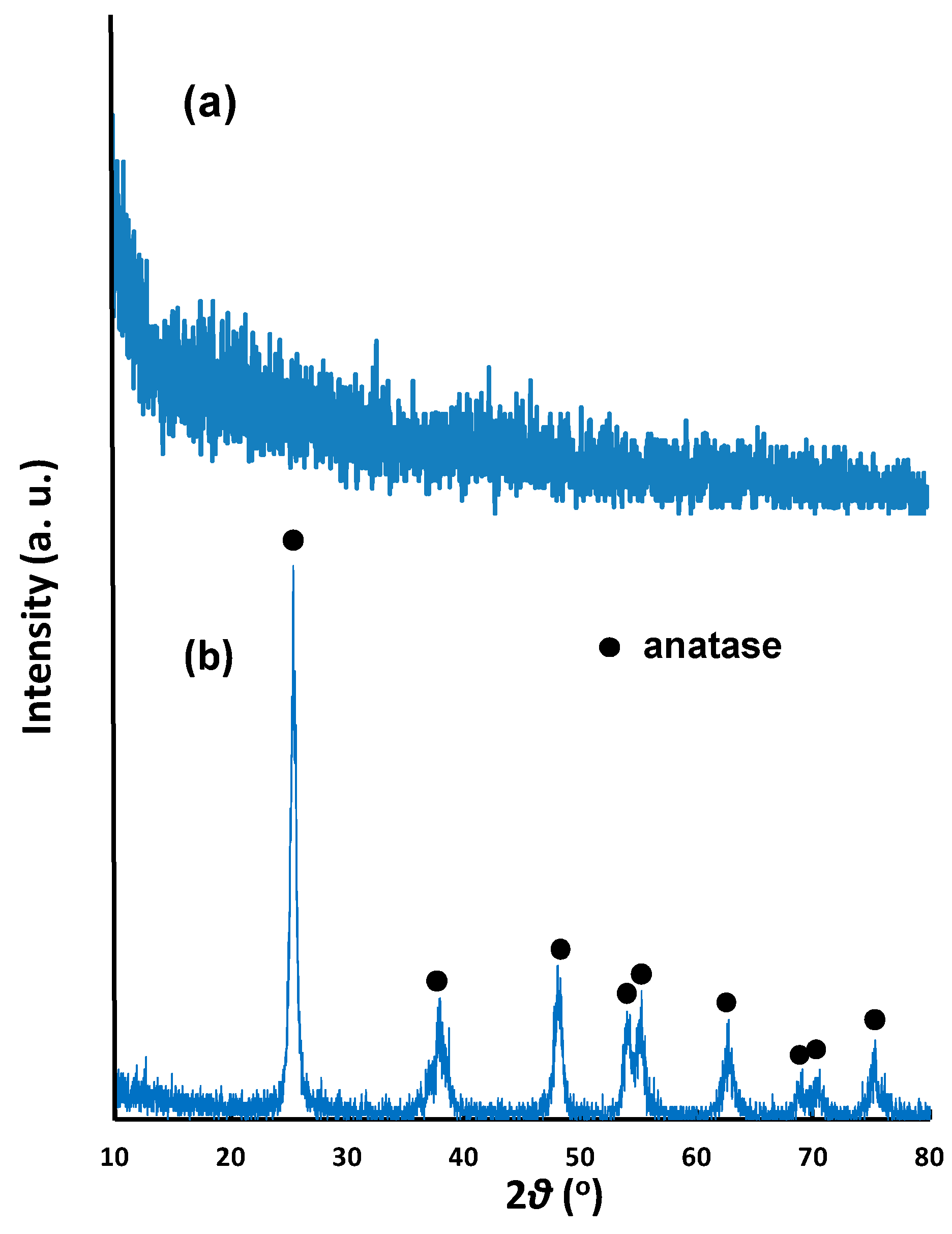

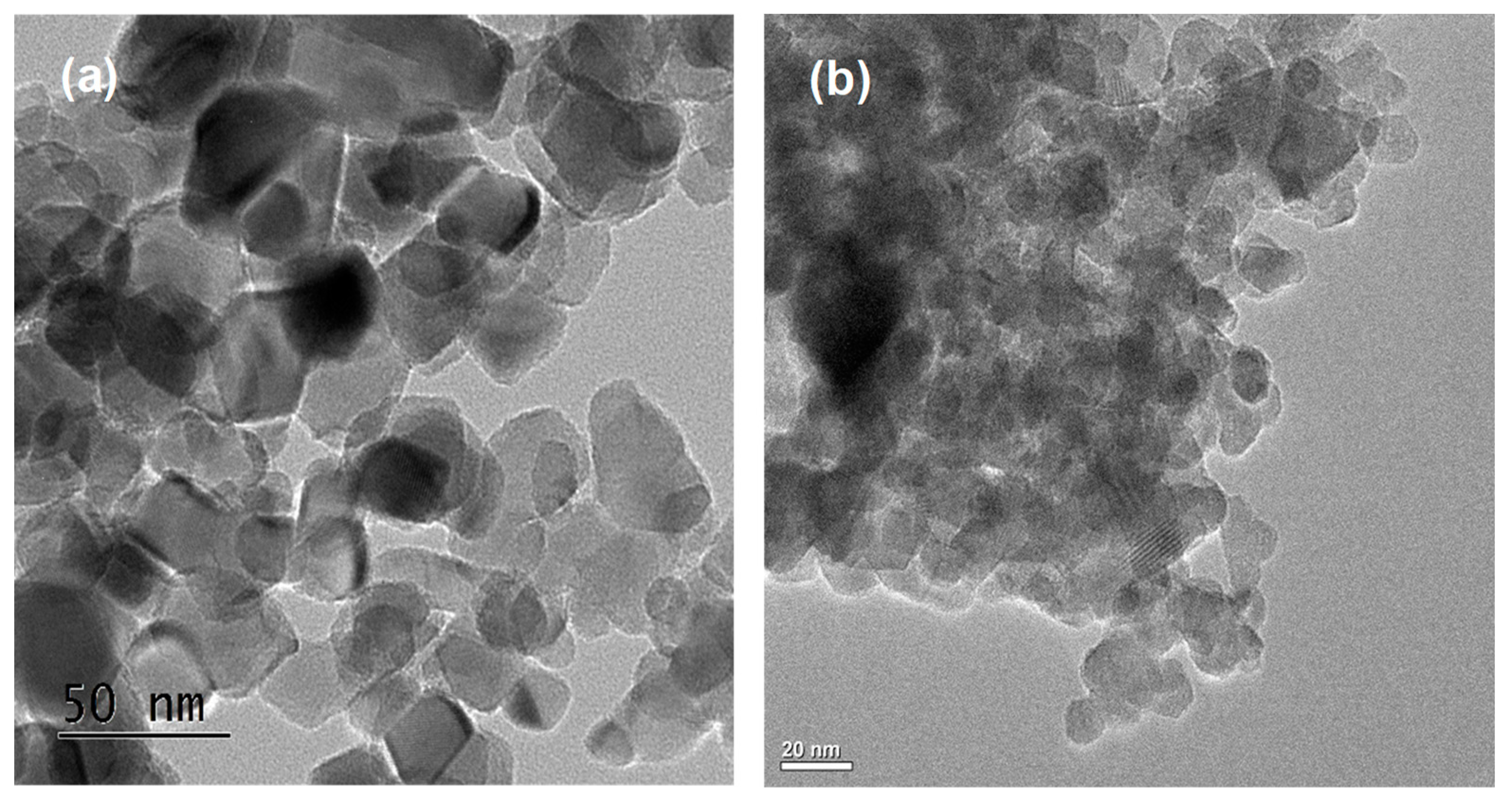
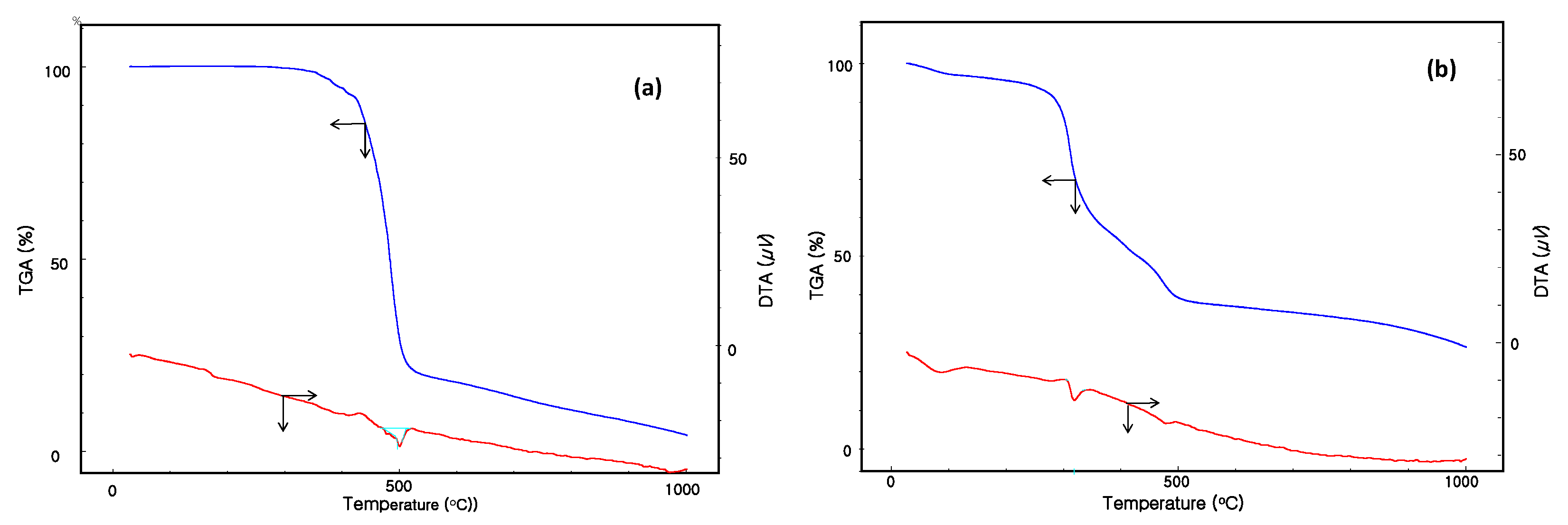
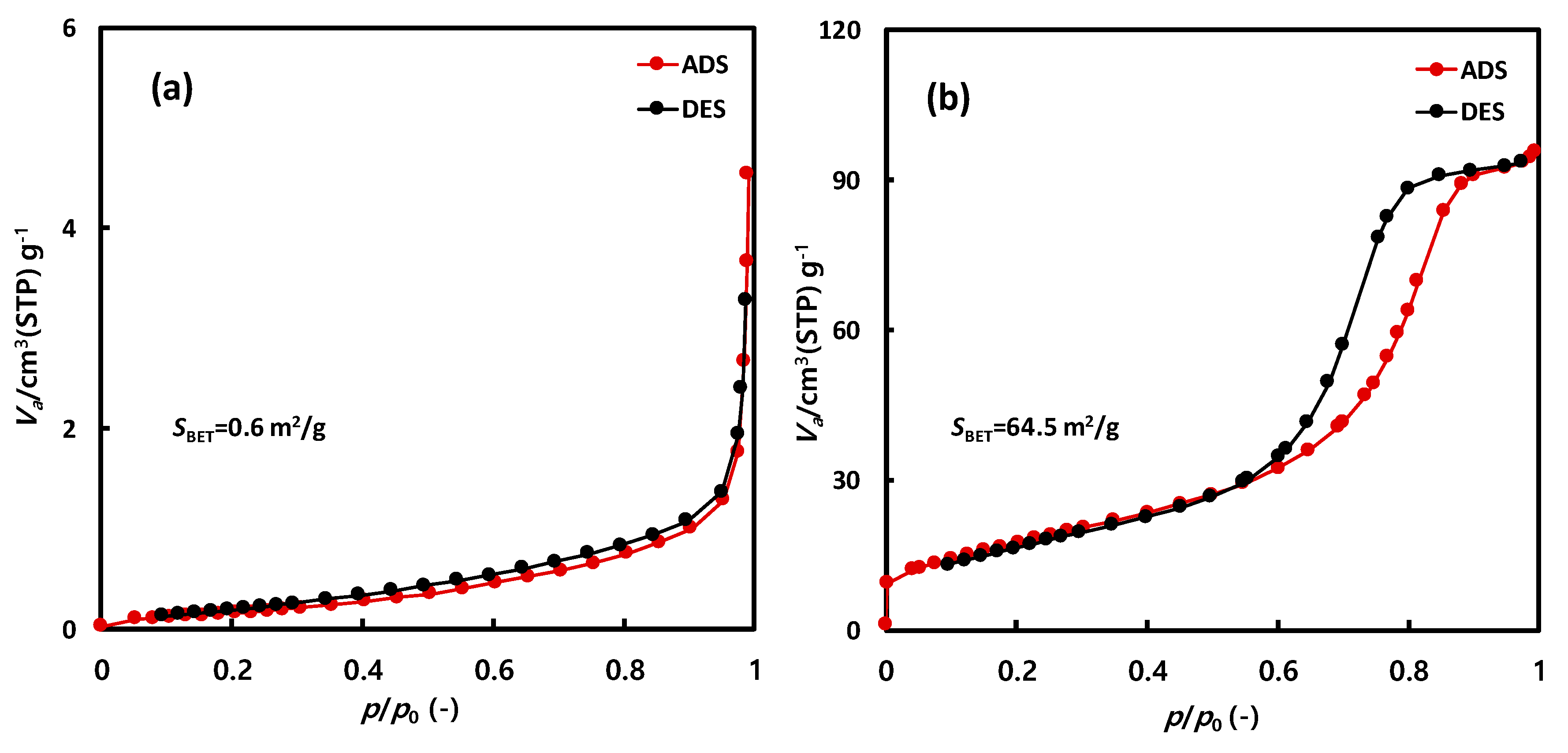

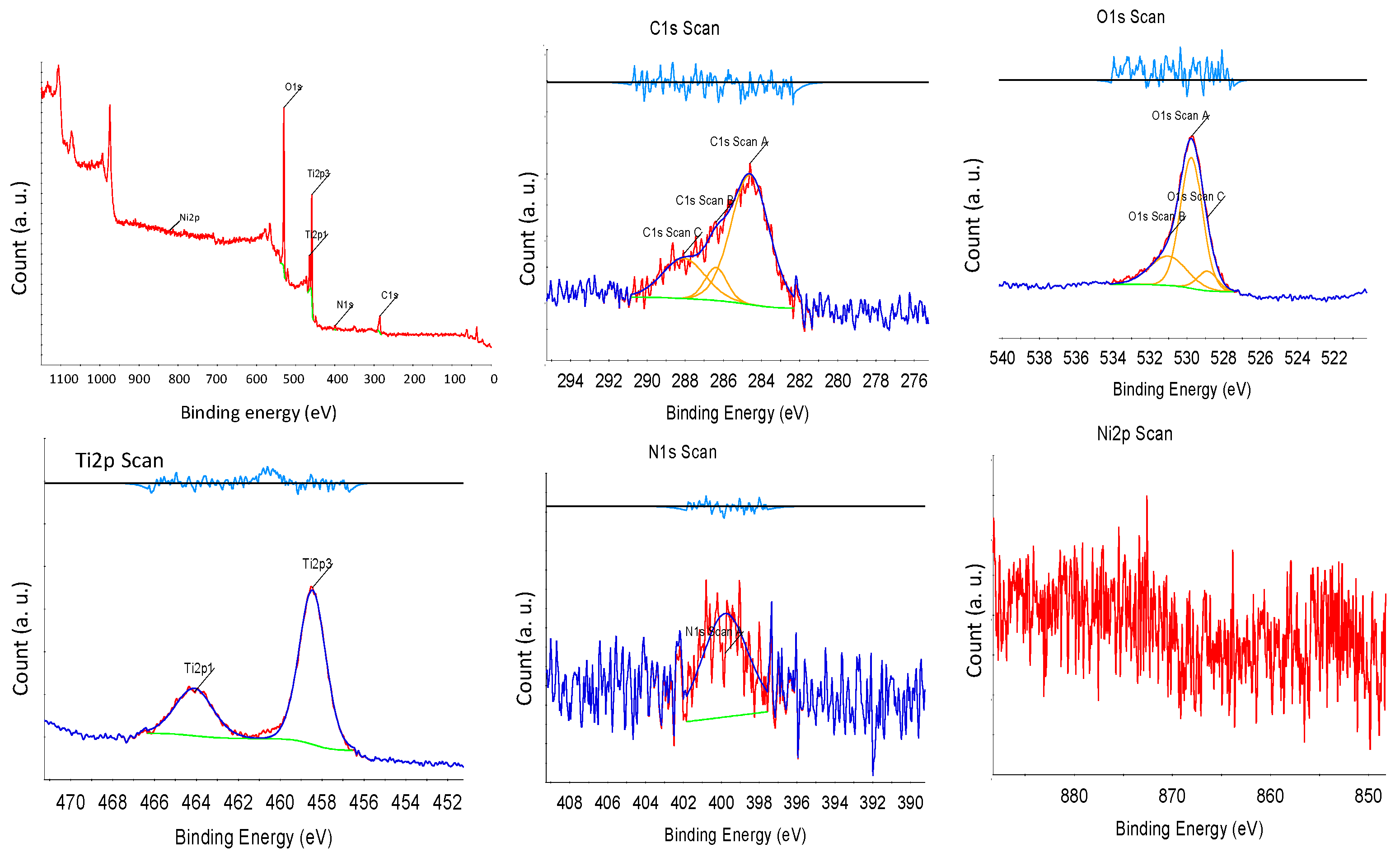
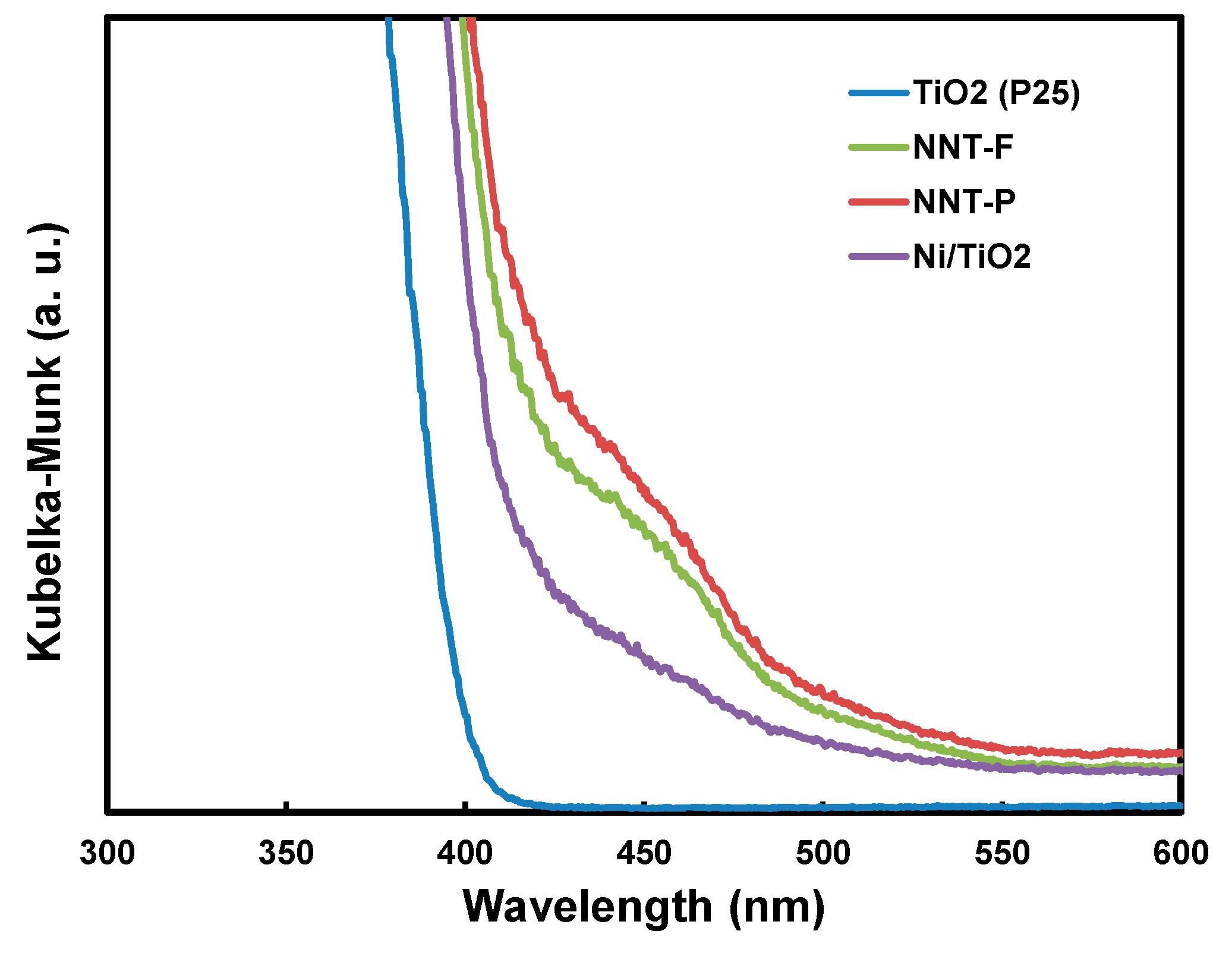
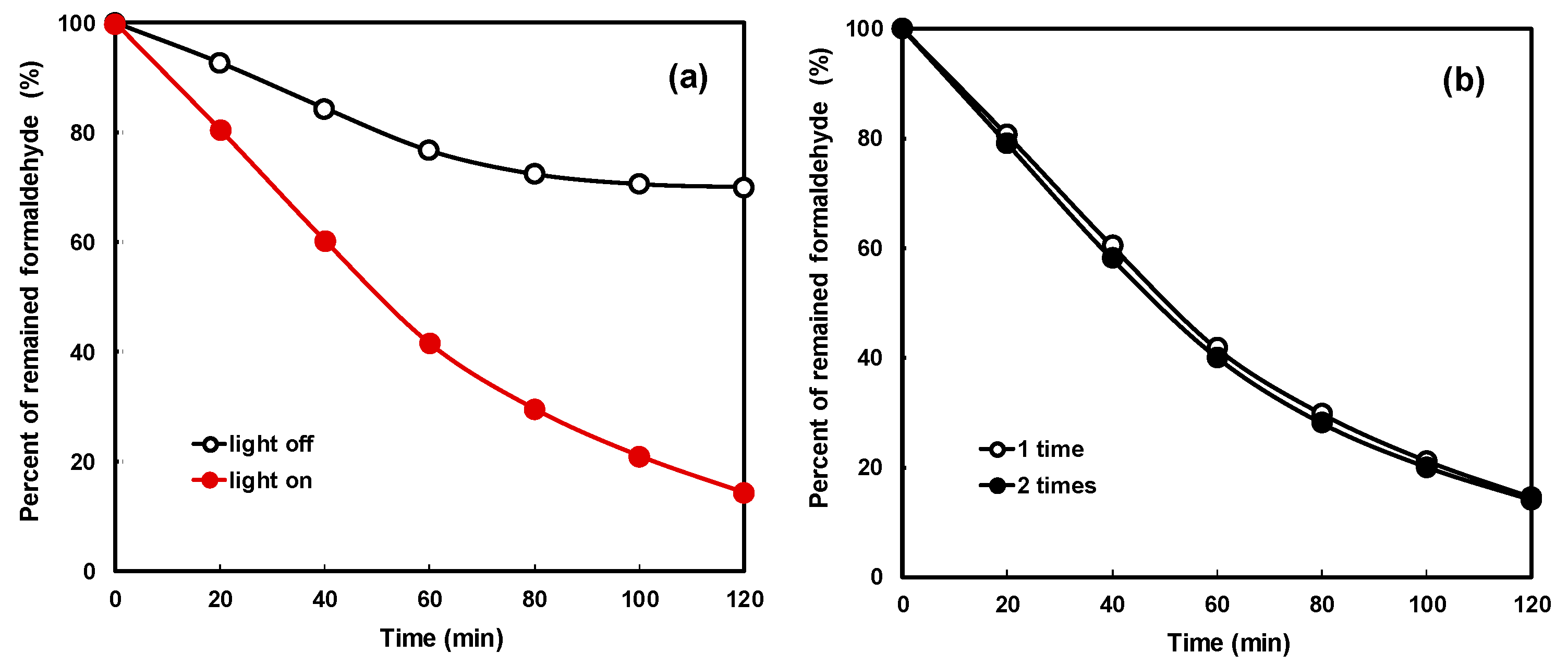

| Pathogenic Bacteria | Assay | Initial Concentration (CFU/mL) | Final Concentration (CFU/mL) | Rate of Sterilization (%) |
|---|---|---|---|---|
| Escherichia coli (ATCC 25922) | lamp coated NNT | 1.5 × 105 | <1.0 × 103 | 99.9 |
| blank | 5.5 × 106 | - | ||
| Staphylococcus aureus (ATCC 6538) | lamp coated NNT | 3.2 × 105 | 2.7 × 103 | 99.2 |
| blank | 1.2 × 107 | - | ||
| Pseudomonas aeruginosa (ATCC 15442) | lamp coated NNT | 2.8 × 105 | <1.0 × 103 | 99.9 |
| blank | 2.1 × 106 | - |
Publisher’s Note: MDPI stays neutral with regard to jurisdictional claims in published maps and institutional affiliations. |
© 2020 by the authors. Licensee MDPI, Basel, Switzerland. This article is an open access article distributed under the terms and conditions of the Creative Commons Attribution (CC BY) license (http://creativecommons.org/licenses/by/4.0/).
Share and Cite
Park, B.-G.; Lee, C.-H.; Chung, K.-H. Visible Light Photocatalytic Activity of Thin Film Coated on Polycarbonate Surface with N- and Ni-Codoped TiO2 Photocatalyst. Catalysts 2020, 10, 1237. https://doi.org/10.3390/catal10111237
Park B-G, Lee C-H, Chung K-H. Visible Light Photocatalytic Activity of Thin Film Coated on Polycarbonate Surface with N- and Ni-Codoped TiO2 Photocatalyst. Catalysts. 2020; 10(11):1237. https://doi.org/10.3390/catal10111237
Chicago/Turabian StylePark, Byung-Geon, Chang-Ho Lee, and Kyong-Hwan Chung. 2020. "Visible Light Photocatalytic Activity of Thin Film Coated on Polycarbonate Surface with N- and Ni-Codoped TiO2 Photocatalyst" Catalysts 10, no. 11: 1237. https://doi.org/10.3390/catal10111237
APA StylePark, B.-G., Lee, C.-H., & Chung, K.-H. (2020). Visible Light Photocatalytic Activity of Thin Film Coated on Polycarbonate Surface with N- and Ni-Codoped TiO2 Photocatalyst. Catalysts, 10(11), 1237. https://doi.org/10.3390/catal10111237




